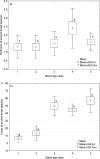Species diversity patterns in managed Scots pine stands in ancient forest sites
- PMID: 31295314
- PMCID: PMC6622550
- DOI: 10.1371/journal.pone.0219620
Species diversity patterns in managed Scots pine stands in ancient forest sites
Abstract
Continuity in forest habitats is crucial for species diversity and richness. Ancient Scots pine forests are usually under forest management, which disturbs vegetation and causes differentiation in terms of tree stand age. To date, vegetation variability in ancient Scots pine forests has not been examined based on tree stand age classes. In the present study the continuity of a large Scots pine forest complex was investigated, and a system of sampling plots established in five tree stand age classes: initiation stands (4-10 years), young stands (20-35 years), middle-aged stands (45-60 years), pre-mature stands (70-85 years) and mature stands (95-110 years). Species composition, including vascular plants, bryophytes and lichens, on soil, tree trunks, and coarse woody debris, was analyzed. Based on existing classifications systems, forest species and ancient forest species groups were distinguished. In the studied ancient Scots pine forests the species pool and richness were relatively low, and the vegetation consisted mostly of generalist species. Cryptogams, which can grow on diverse substrates, were the most abundant species. Moreover, most species could tolerate both forest and non-forest conditions. Age class forests provided different environmental niches for species. Initiation stands were optimal for terrestrial light-demanding species, and in terms of species composition, initiation stands were most specific. Young stands were most preferred by species on coarse woody debris, and at this stage of stand maturation epiphytic species re-appeared. The oldest stands were not rich in forest specialists, i.e. species of closed forest and ancient forest species. Cryptogams of closed forests inhabited different substrates, and they were not associated only with the oldest stands. The low number of forest specialists in the oldest stands may be a general feature of acidophilus pine forests. However, it may also be a result of the lack of species sources in the vicinity of maturing pine stands. In managed forests a frequent diversity pattern is an increase in a species pool and richness after clear-cut logging. In the present study we obtained higher species pools in initiation and young stands, but richness was similar in all tree stand age classes. This resulted from taking into account species of different substrates (terrestrial, epixylous and epiphytic species) which changed their participation in the vegetation of subsequent stages of tree stand development.
Conflict of interest statement
The authors have declared that no competing interests exist.
Figures







Similar articles
-
Potential implications of shortened rotation length for forest birds, bryophytes, lichens and vascular plants: An example from southern Swedish production forests.PLoS One. 2023 Dec 15;18(12):e0289835. doi: 10.1371/journal.pone.0289835. eCollection 2023. PLoS One. 2023. PMID: 38100411 Free PMC article.
-
A Pine Is a Pine and a Spruce Is a Spruce--The Effect of Tree Species and Stand Age on Epiphytic Lichen Communities.PLoS One. 2016 Jan 22;11(1):e0147004. doi: 10.1371/journal.pone.0147004. eCollection 2016. PLoS One. 2016. PMID: 26799558 Free PMC article.
-
Rapid Increases in forest understory diversity and productivity following a mountain pine beetle (Dendroctonus ponderosae) outbreak in pine forests.PLoS One. 2015 Apr 10;10(4):e0124691. doi: 10.1371/journal.pone.0124691. eCollection 2015. PLoS One. 2015. PMID: 25859663 Free PMC article.
-
The tree species matters: Biodiversity and ecosystem service implications of replacing Scots pine production stands with Norway spruce.Ambio. 2020 May;49(5):1035-1049. doi: 10.1007/s13280-019-01259-x. Epub 2019 Sep 24. Ambio. 2020. PMID: 31552644 Free PMC article. Review.
-
Biodiversity differences between managed and unmanaged forests: meta-analysis of species richness in Europe.Conserv Biol. 2010 Feb;24(1):101-12. doi: 10.1111/j.1523-1739.2009.01399.x. Conserv Biol. 2010. PMID: 20121845 Review.
Cited by
-
Together Apart: Evaluating Lichen-Phorophyte Specificity in the Canarian Laurel Forest.J Fungi (Basel). 2022 Sep 29;8(10):1031. doi: 10.3390/jof8101031. J Fungi (Basel). 2022. PMID: 36294596 Free PMC article.
References
-
- Matías L, Jump AS. Interactions between growth, demography and biotic interactions in determining species range limits in a warming world: the case of Pinus sylvestris. For Ecol Manage. 2012; 282: 10–22. 10.1016/j.foreco.2012.06.053 - DOI
-
- Houston Durrant T, de Rigo D, Caudullo G. Pinus sylvestris in Europe: distribution, habitat, usage and threats In: San-Miguel-Ayanz J, de Rigo D, Caudullo G, Houston Durrant T, Mauri A, editors. European Atlas of Forest Tree Species. Luxembourg: Publ Off EU; 2016; pp. e016b94+
-
- Mason WL, Alía R. Current and future status of Scots pine (Pinus sylvestris L.) forests in Europe. For Syst. 2000; 9(S1): 317–335.
-
- Leuschner C, Ellenberg H. Ecology of Central European forests: vegetation ecology of Central Europe, vol 1 Berlin: Springer; 2017.
MeSH terms
LinkOut - more resources
Full Text Sources

